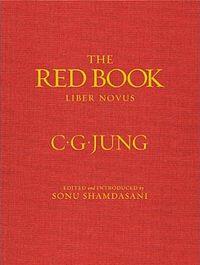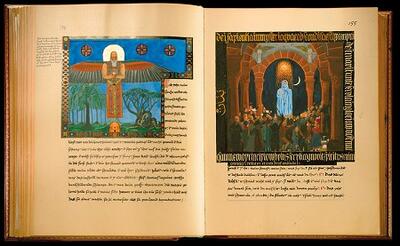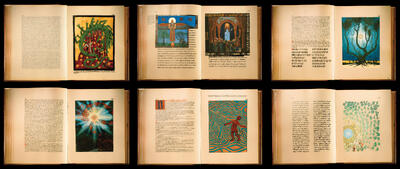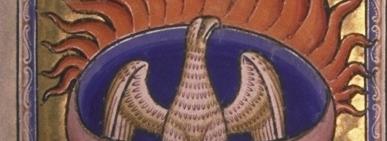


Liber Novus
C.G. Jung's Personal Journal
“There is a human story here.
The basic message Jung is sending is, ‘Value your inner life.’ ”
~ Sonu Shamadasani
In his introduction to the Red Book, editor Sonu Shamdasani summarizes the importance of the work:
History
Around the time of World War I, C.G. Jung commenced on an extended self-exploration that he called his “Confrontation with the Unconscious”. During this period, Jung developed his principal theories of the collective unconscious, the archetypes, psychological types and the process of individuation, and transformed psychotherapy from a practice concerned with the treatment of pathology into a means for reconnection with the soul and the recovery of meaning in life.
At the heart of this endeavor was his legendary Red Book, a large, leather bound, illuminated volume that he created between 1914 and 1930, and which contained the nucleus of all his later works.
While Jung considered the Red Book, or Liber Novus (New Book), to be the central work in his oeuvre, it has remained unpublished until the end of 2009, and unavailable for study and unseen by the public at large. The work can be best described as a work of psychology in a literary and prophetic form. It is possibly the most influential previously unpublished work in the history of psychology. Its publication is a watershed that inaugurates a new era in the understanding of Jung’s life and work.
“This life is the way,
the long sought-after way to the unfathomable
which we call divine.”
~ C.G. Jung,
from The Red Book, p. 232

The Red Book is edited and introduced by Sonu Shamdasani. It was translated by Mark Kyburz, John Peck and Sonu Shamdasani. Ulrich Hoerni provides a foreword.
Sonu Shamdasani is the General Editor and Co-Founder of the Philemon Foundation. He is also a Professor of Psychology and the Philemon Reader in Jung History at the Wellcome Trust Centre for the History of Medicine at University College London.
The Red Book was published on October 7, 2009 by W. W. Norton & Company. It is a scholarly and historical edition made accessible to the general reader by an introduction that sketches the social and intellectual context of the work, its history, and the circumstances in which it arose.
The folio size (11.57 inches by 15.35 inches) volume, exactly the same size as the original, consists of 205 pages of text in Jung’s masterful calligraphic hand and, from his skilled brush, stunning paintings. Of them, 53 pages are full images, 71 pages contain both text and 81 images and pages are pure calligraphic text.
Sonu Shamdasani introducing The Red Book Exhibition
at the Rubin Museum in New York City.
Furthermore, when the original book was shepherded around this country on a national tour it drew standing-room-only crowds to the venues where it was presented and discussed. During two such events, The Hammer Museum in Los Angeles and the Rubin Museum of Art in New York City sponsored on-stage pairing of Jungian Analysts and world-renowned musicians, film directors, artists and writers such as Alice Walker, Leonard Nimoy, Meredith Monk and Jack Kornfield, as well as many others, inviting their reactions to the writing and imagery of the Red Book. Videos and podcasts of these encounters, which often involve audience participation, are available on the websites of the Philemon Foundation, the Rubin Museum and the mercurial Youtube.
"This [The Red Book] he composed during a state of "active imagination" -- that is, of reverie or waking dream. As he said, he wanted to see what would happen when he "switched off consciousness." To the modern reader, the result recalls an allegorical-mythological amalgam of Nietzsche's "Also Sprach Zarathustra," Blake's illuminated poems, Renaissance Neoplatonic dialogue, Eastern scripture, Dante's "Inferno," Yeats's "A Vision" and even the biblical book of Revelation. Jung's pictures sometimes resemble simplified versions of Georgia O'Keeffe's flower paintings and sometimes the symbol-laden images in treatises about alchemy (a subject that Jung was soon to study intently). Throughout, one finds illuminated capitals, interlaced roundels that call to mind stained-glass windows, stars, half moons, swords, crosses, dying animals. Jung also drew circular patterns that he later recognized as versions of the mystical shape called the mandala. "The Red Book" was never published during the psychologist's lifetime, though a few friends and disciples were allowed to examine it. Apparently Jung felt it was not only too personal and quirky for publication, but also that he had already mined the text for the insights set forth in his later writings. As editor Sonu Shamdasani stresses, "The overall theme of the book is how Jung regains his soul and overcomes the contemporary malaise of spiritual alienation. This is ultimately achieved through enabling the rebirth of a new image of God in his soul and developing a new worldview in the form of a psychological and theological cosmogony."



